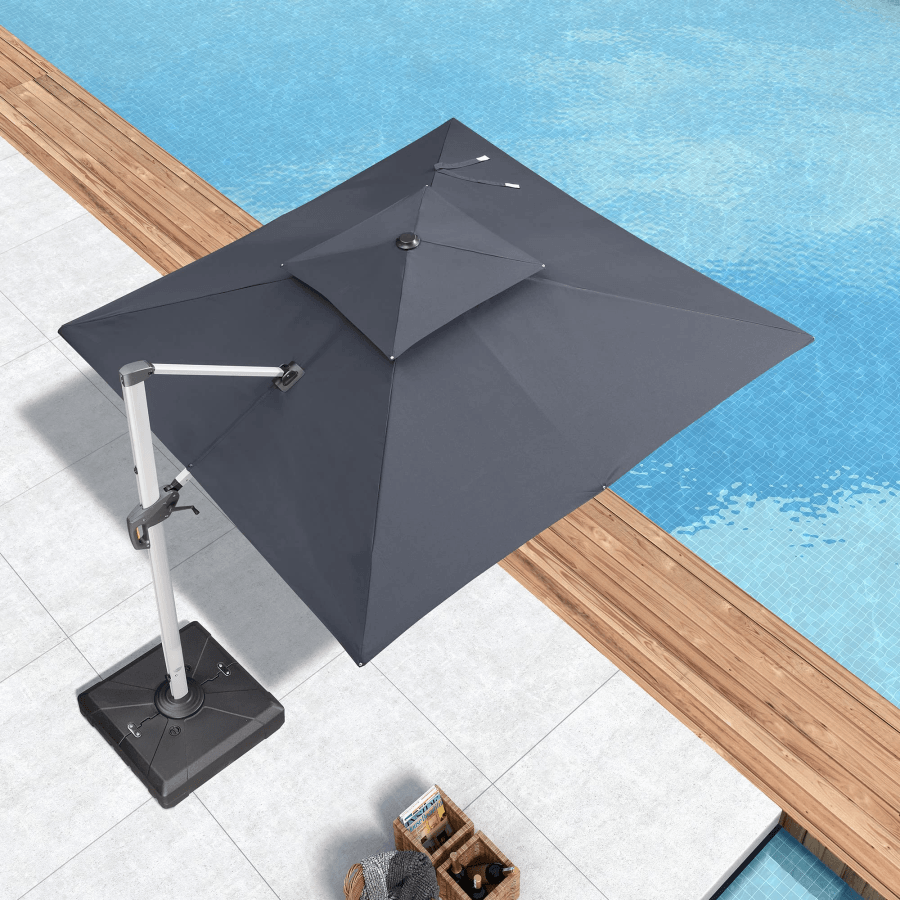Transform Your Backyard: The Ultimate Guide to Choosing the Perfect Square Umbrella!
When it comes to enhancing your backyard, few elements are as transformative as a stylish outdoor umbrella. A square outdoor umbrella with a stand not only adds an aesthetic charm to your space but also serves a practical purpose by providing shade and protection from the sun's harsh rays. Whether you’re hosting a summer barbecue, enjoying a quiet afternoon with a book, or simply relaxing with friends, the right umbrella can make all the difference. In this guide, we’ll delve into the various aspects of choosing the perfect square outdoor umbrella, ensuring that you make an informed decision that aligns with your needs and preferences.

Why Choose a Square Outdoor Umbrella?
Square outdoor umbrellas offer a unique blend of functionality and style that sets them apart from their round counterparts. Their geometric shape allows for optimal coverage, making them particularly well-suited for rectangular tables or lounge areas. A square umbrella can efficiently utilize space since it provides shade in a more defined area, preventing the sun from creeping in at the corners. Aesthetically, square umbrellas can complement modern outdoor designs and add a contemporary flair to your backyard. Additionally, they can be positioned closer to walls or fences, allowing for more flexible placement options without sacrificing shade. This versatility makes square umbrellas a popular choice for homeowners looking to maximize their outdoor experience.
Key Features to Consider
Choosing the right square outdoor umbrella with a stand involves considering several key features that impact its performance and longevity. First and foremost, the materials used in both the canopy and the frame are crucial. Look for durable fabrics that can withstand the elements, such as UV-resistant polyester or acrylic, which can protect you from harmful rays while resisting fading. The frame should ideally be made from materials like aluminum or steel, which provide a sturdy base while also being lightweight enough for easy maneuverability.
Materials
The choice of materials for both the canopy and the frame can significantly affect the umbrella's durability. Canopies made from polyester offer a good balance of affordability and UV protection, while acrylic canopies tend to be more resistant to fading and mildew. On the frame side, aluminum is lightweight and rust-resistant, making it ideal for outdoor use, whereas steel frames are heavier and provide additional stability but may require more maintenance to prevent rusting.
Size
Determining the appropriate size for your square outdoor umbrella largely depends on the intended use and the space available in your backyard. If you plan to use it over a dining table, ensure that the umbrella is large enough to provide ample shade for all seated individuals. A general rule of thumb is to choose an umbrella that extends at least 2 feet beyond the edges of your table for optimal coverage. If your goal is to create a cozy lounging area, consider the dimensions of your seating arrangement to ensure that the umbrella provides sufficient shade without overwhelming the space.
Durability
Durability is another key factor when selecting a square outdoor umbrella. Look for models that are specifically designed to withstand wind and rain. Umbrellas with wind vents allow air to flow through, reducing the risk of damage during gusty conditions. Additionally, check for UV protection ratings on the fabric to ensure it can resist fading and maintain its vibrant color over time. A good quality umbrella should also come with a warranty, which can be an indicator of the manufacturer's confidence in their product's durability.
Choosing the Right Stand
While the umbrella itself is important, selecting the right stand is equally crucial for stability and safety. A good stand will keep your umbrella securely in place, even on windy days. There are various types of stands available, each with its unique features. Weighted stands are popular because they provide a solid base, while portable stands can be convenient for those who want the flexibility to move their umbrella around. The choice of stand will depend on your specific needs and how you plan to use the umbrella.
Types of Stands
There are several types of umbrella stands to consider. Weighted stands typically use concrete or sand to provide stability and are ideal for stationary setups. Portable stands, on the other hand, are designed for easy transport, making them perfect for beach trips or outdoor events. If you have a patio or deck, a table with a built-in umbrella hole can serve as a stand, allowing you to utilize existing furniture while providing a sleek look.
Weight and Stability
When evaluating the stability of an umbrella stand, the weight is a primary consideration. Generally, a heavier base will provide better stability, especially in windy conditions. Look for stands that can accommodate additional weight, such as adding sandbags or water weights, to enhance stability further. Additionally, the design of the base itself plays a role; a broader base can distribute weight more evenly, reducing the risk of tipping over.
Maintenance and Care Tips
To ensure your square outdoor umbrella remains functional and aesthetically pleasing for years to come, regular maintenance is essential. Start by checking the canopy for signs of wear and tear, such as rips or fading. If you notice any issues, address them promptly to prevent further damage. Regularly remove debris and dirt using a mild soap solution and a soft cloth, and be sure to rinse thoroughly with clean water. During harsh weather conditions, it is a good idea to store the umbrella in a safe place, such as a covered area or indoors, to prolong its lifespan. Consider using a protective cover during off-season, as this will shield it from UV rays, rain, and other elements.
Selecting the Ideal Umbrella for Your Outdoor Space
Choosing the right square outdoor umbrella with a stand is an investment that can greatly enhance your backyard experience. By considering factors such as shape, materials, and durability, you can select an umbrella that not only meets your aesthetic preferences but also provides the necessary protection from the elements. Remember to choose a stand that offers stability and complements your outdoor setup. With proper maintenance and care, your umbrella can become a staple of your outdoor oasis, allowing you to enjoy your backyard to the fullest.













